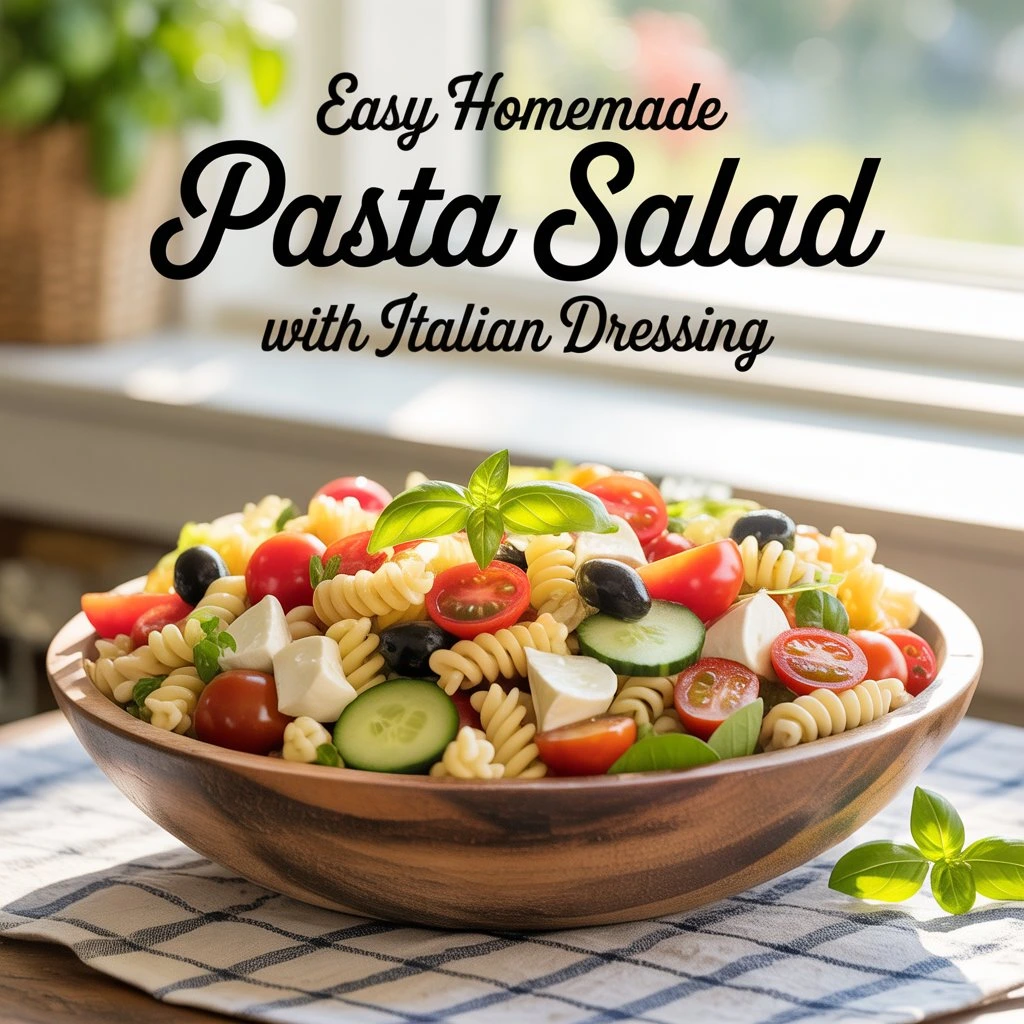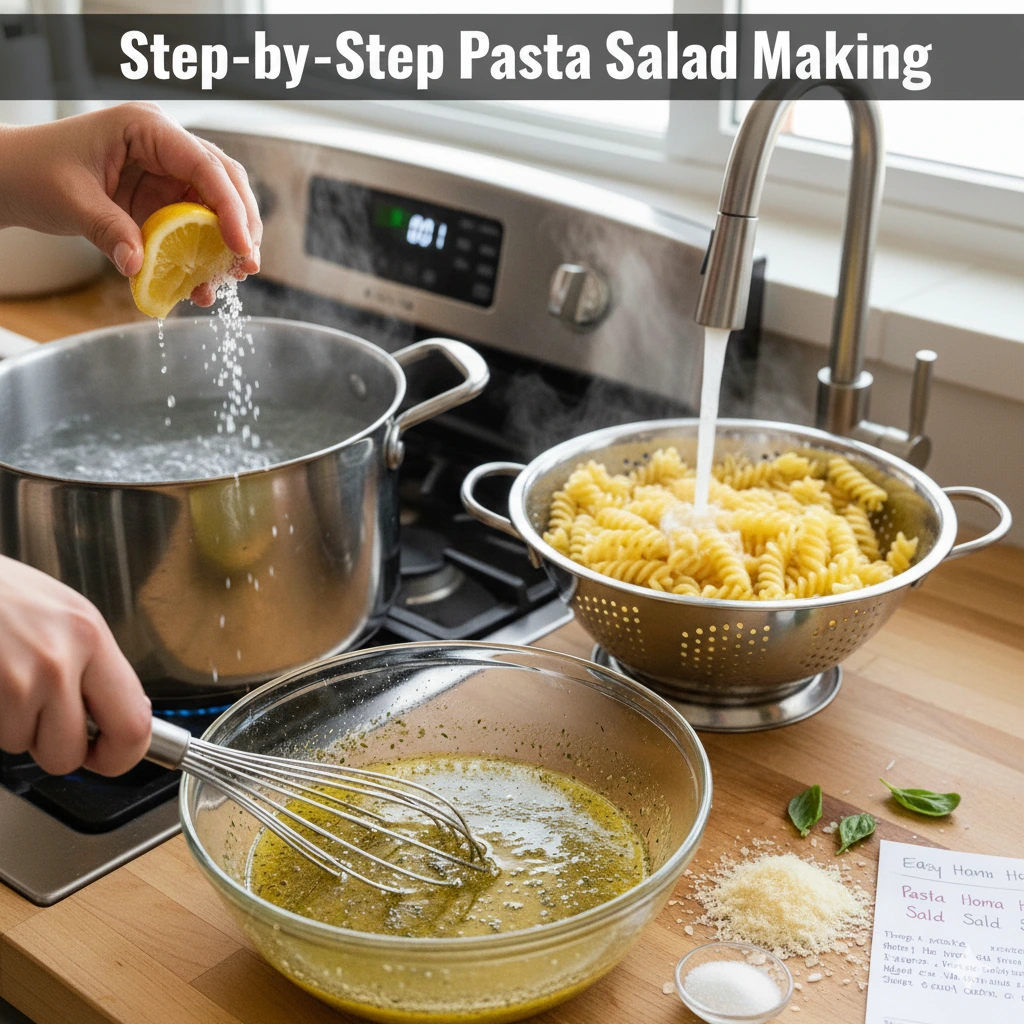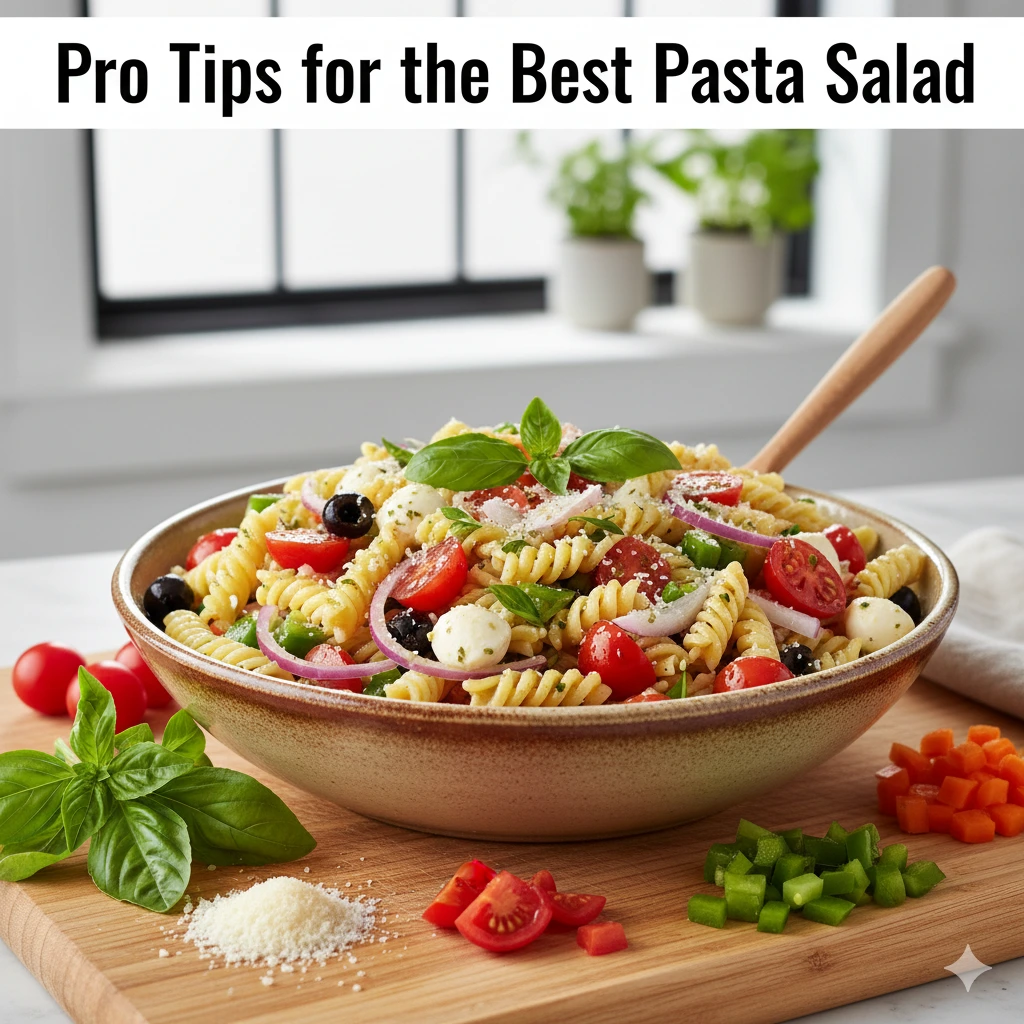
If you’re searching for an Easy Homemade Pasta Salad with Italian Dressing, then you’re in the right place. This recipe is one of my favorites to prepare when I need something simple yet satisfying for family gatherings, potlucks, or even a quick weekday meal.
Why Italian dressing? Personally, I love how it balances tangy vinegar, smooth olive oil, and aromatic herbs like oregano and basil. It’s light yet flavorful, and it doesn’t overpower the pasta or fresh veggies. Every bite feels refreshing, which makes it perfect for both warm summer evenings and casual family dinners.
In this article, we’ll walk through everything step by step. First, the ingredients, then cooking the pasta, preparing the dressing, mixing it all together, and finally storage and variations. Along the way, I’ll also share little experiences — like how I sometimes tweak the recipe depending on who I’m serving — because pasta salad is one of those dishes you can truly make your own.
Ingredients Breakdown (Homemade Pasta Salad with Italian Dressing)
Whenever I prepare pasta salad, I like to set all ingredients out on the counter before starting. It makes the process smooth and prevents that last-minute panic of realizing you forgot something.
Pasta Salad Ingredients
- Pasta type – Rotini is my go-to because its spirals hold the dressing so well. Fusilli works the same way, and penne gives a slightly firmer bite. I once tried farfalle (bow-tie pasta), and though it looked cute, it didn’t hold the dressing as nicely.
- Fresh vegetables – Cherry tomatoes, bell peppers, red onions, cucumbers, and black olives are must-haves for me. They bring both crunch and color. Sometimes, if I have them in the fridge, I’ll add roasted zucchini or even corn for a sweeter bite.
- Cheese options – Mozzarella pearls are creamy and mild, while parmesan adds sharpness. Personally, I like to combine the two for balance.
- Optional add-ins – My husband loves when I throw in sliced salami or pepperoni. I don’t always do it, but for parties, it makes the salad more filling. Pepperoncini is also a nice touch for those who like a little heat.
Italian Dressing Ingredients
Now, about the dressing — I’ve tried both bottled and homemade versions. Store-bought can save time, but honestly, homemade always feels fresher.
- Olive oil – Use good quality; it really makes a difference.
- Vinegar – I mostly use red wine vinegar, but white wine vinegar works too. Sometimes, I even add a splash of balsamic if I want a slightly sweeter finish.
- Lemon juice – I never skip this. It brightens everything.
- Herbs and spices – Oregano, basil, parsley, garlic powder, salt, and black pepper. I also add fresh basil if I have it.
- Balancing flavors – A pinch of sugar helps if the dressing feels too sharp. Parmesan or Dijon mustard adds body and makes the dressing cling better to the pasta.
Step-by-Step Instructions

Let’s move to the cooking part. I’ll guide you through as if we’re in the kitchen together.
Cooking the Pasta
This step may seem basic, but trust me, the texture of the pasta can make or break your salad.
- Boil water generously – Use a large pot and add plenty of salt. I once made the mistake of skimping on salt, and the whole salad tasted flat. The pasta should be seasoned from the inside.
- Cook al dente – Follow the package, but I always stop one minute earlier. Pasta will continue to soften once it’s mixed with dressing.
- Drain and cool – Drain well and rinse lightly under cold water. Some people don’t rinse, but I’ve found that a quick rinse helps stop cooking and keeps the pasta from sticking.
Now, with the pasta ready, let’s prepare the star of the show — the dressing.
Making the Italian Dressing
Since this recipe is all about Easy Homemade Pasta Salad with Italian Dressing, the dressing deserves extra care.
- Mix the base – Whisk olive oil and vinegar in a bowl. I usually use a 3:1 ratio.
- Add seasonings – Stir in oregano, basil, garlic powder, salt, and pepper. If you love bold flavors like me, don’t be shy with the herbs.
- Brighten the flavor – Fresh lemon juice adds life. I sometimes add zest as well for extra freshness.
- Balance it out – Taste test. If it’s too acidic, add a pinch of sugar. Parmesan makes it richer and helps the dressing cling.
Once, I added too much vinegar and thought it was ruined. But adding a little parmesan and olive oil balanced everything perfectly. So don’t panic if your first try feels off — you can adjust.
Combining Everything
Now comes the part I enjoy the most — watching all the colors and textures come together.
- Coat the pasta first – Toss the pasta with half the dressing so it absorbs flavor.
- Add vegetables and cheese – Tomatoes, peppers, onions, olives, and mozzarella go in next.
- Optional proteins – On busy weeknights, I sometimes add leftover grilled chicken. It turns the salad into a full meal.
- Mix gently – Stir carefully so nothing breaks.
- Finish with dressing – Add the rest and give it one final toss.
At this point, it smells amazing, but don’t rush. The next step makes a big difference.
Chilling Before Serving
Good pasta salad isn’t just mixed; it’s rested.
- Refrigerate for 30–60 minutes – This allows the flavors to blend and deepen.
- Stir before serving – The dressing may settle at the bottom, so give it a quick toss before you serve.
I have already shared step-by-step instructions with my personal tips, but if you’d like to explore more variations of pasta salad, here’s a great Quora guide I found helpful.
Make-Ahead & Storage Tips
One of the best things about pasta salad is that it can be made ahead of time. Here’s how to manage it:
- Make ahead – I often cook the pasta the night before and chop the veggies in the morning.
- Store dressing separately – If I’m making it for a party, I keep dressing in a jar and pour it right before serving. This keeps everything fresh.
- Fridge life – Pasta salad lasts 3–4 days if kept in an airtight container.
- Refresh before serving – I always add a drizzle of olive oil or lemon juice when serving leftovers. It revives the flavors instantly.
Pro Tips for the Best Pasta Salad

Let’s pause and talk about some tricks that can turn a good pasta salad into a great one.
- Don’t overcook pasta – Soft pasta makes the salad mushy.
- Use fresh herbs and cheese – Fresh basil or parsley brings unmatched flavor.
- Cut vegetables evenly – This way, every bite has a balance of pasta and veggies.
- Chill thoroughly – A cold pasta salad is refreshing and flavorful.
- Balance the dressing – Too much makes it soggy, too little makes it bland.
Variations & Customizations
Here’s where you can have fun and make this recipe your own.
- Protein options – Grilled chicken, tuna, or shrimp make it a complete meal. I once tried adding grilled salmon, and surprisingly, it worked beautifully.
- Vegetarian twists – Chickpeas, roasted zucchini, or sun-dried tomatoes are amazing additions.
- Gluten-free swaps – Corn or quinoa pasta works well for those avoiding gluten.
- Creamy version – Sometimes, I mix Italian dressing with Greek yogurt. It makes the salad tangier and creamier.
- Seasonal veggies – Sweet corn in summer, roasted pumpkin in fall, cucumbers in spring — I like adjusting based on what’s fresh.
Sometimes we all like to learn from different perspectives. That’s why I’m sharing another useful resource where you can get extra discussion and ideas about pasta salads.
What to Serve With Pasta Salad
Pasta salad is versatile, which is why I keep coming back to it.
- Grilled meats – Chicken, steak, or sausages pair perfectly.
- BBQ dishes – I often serve it with burgers at family cookouts.
- Garlic bread – A warm side makes the meal feel complete.
- Light veggies – Roasted or steamed vegetables work well.
- Picnic spreads – This is hands down one of my favorite picnic foods. It packs well and tastes even better cold.
Frequently Asked Questions (FAQs)
Q: Why does my pasta salad taste bland?
A: You may not be adding enough salt to the pasta water, or your dressing may need extra seasoning. Always taste and adjust.
Q: Should it be served cold or warm?
A: Pasta salad is best served cold or at least chilled. It gives time for the flavors to blend.
Q: Is salting pasta water necessary?
A: Yes! It seasons the pasta from within. Skipping this step often makes the salad taste flat.
Q: How do I keep pasta from sticking?
A: Stir during boiling and rinse briefly after draining. Tossing with a little dressing also prevents clumps.
Q: What pasta shape is best?
A: Rotini and fusilli are great because their twists hold dressing, but penne and farfalle also work well.
Conclusion
We’ve covered everything step by step, from cooking pasta to preparing the dressing and storing leftovers. Making an Easy Homemade Pasta Salad with Italian Dressing isn’t complicated, but it does benefit from a little care in each step.
Remember: don’t overcook your pasta, season your dressing well, and let the salad chill before serving. With these tips, you’ll have a dish that’s not only colorful and inviting but also bursting with flavor.
Now it’s your turn — grab the ingredients, follow these steps, and create a pasta salad that your family and friends will request again and again. And once you’ve mastered this classic version, don’t be afraid to experiment with your own variations. After all, pasta salad is all about flexibility and fun!
